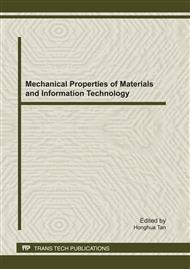[1]
M.L. Pinedo. Scheduling: Theory, Algorithms and Systems. 2nd Edition. New Jersey: Prentice-Hall, Inc. (2002).
Google Scholar
[2]
M.L. Pinedo. Planning and Scheduling in Manufacturing and Services. 1st Edition. Springer-Verlag: New York. (2005).
Google Scholar
[3]
K.R. Baker and J.W. Bertrand. A dynamic priority rule for sequencing against due dates. Journal of Operations Management, 3, 37-42. (1982).
DOI: 10.1016/0272-6963(82)90020-1
Google Scholar
[4]
K.R. Baker and J.W. Bertrand. A dynamic priority rule for sequencing against due dates. Journal of Operations Management, 3, 37-42. (1982).
DOI: 10.1016/0272-6963(82)90020-1
Google Scholar
[5]
Y. Chen, M.E. Pfund, J.W. Fowler, D.C. Montgomery and T.E. Callarman. Robust scaling parameters for composite dispatching rules. IIE Transactions, 42, 842-853. (2010).
DOI: 10.1080/07408171003685825
Google Scholar
[6]
S.Y. Kim, Y.H. Lee and D. Agnihotri. A Hybrid approach to sequencing jobs using heuristic rules and neural network. Production Planning and Control, 6(5), 445-454. (1995).
DOI: 10.1080/09537289508930302
Google Scholar
[7]
Y.H. Lee, K. Bhaskaran and M. Pinedo. A heuristic to minimize the total weighted tardiness with sequence-dependent setups. IIE Transactions, 29, 45-52. (1997).
DOI: 10.1080/07408179708966311
Google Scholar
[8]
Y.H. Lee and M. Pinedo. Scheduling jobs on parallel machines with sequence dependent setup times. European Journal of Operational Research, 100, 464-474. (1997).
DOI: 10.1016/s0377-2217(95)00376-2
Google Scholar
[9]
T. Morton and D. Pentico. Heuristic Scheduling Systems: with Applications to Production Systems and Project Management. New York: John Wiley and Sons. (1993).
Google Scholar
[10]
Y. Park, S. Kim, and Y.H. Lee. Scheduling jobs on parallel machines applying neural network and heuristic rules. Computers and Industrial Engineering, 38, 189-202. (2000).
DOI: 10.1016/s0360-8352(00)00038-3
Google Scholar
[11]
M.E. Pfund, J.W. Fowler, A. Gadkari, and Y. Chen. Scheduling Jobs on Parallel Machines with Setup Times and Ready Times, Computers and Industrial Engineering, 54(4), 764-782. (2008).
DOI: 10.1016/j.cie.2007.08.011
Google Scholar
[12]
R.V. Rachamadugu and T.E. Morton. Myopic heuristics for the single machine weighted tardiness problem. Working Paper, 30-82-83, GSIA. Pittsburgh, PA: Carnegie Mellon University. (1982).
Google Scholar
[13]
A. Vepsalainen and T. Morton. Priority rules for job shops with weighted tardiness costs. Management Science, 33, 1035-1047. (1987).
DOI: 10.1287/mnsc.33.8.1035
Google Scholar
[14]
E.L. Lawler, J.K. Lenstra and A.H.G. Rinnooy Kan. Recent developments in Deterministic Sequencing and Scheduling: A Survey. Deterministic and Stochastic Scheduling, Dempster, Lenstra and Rinnooy Kan (eds), 35-74. (1982).
DOI: 10.1007/978-94-009-7801-0_3
Google Scholar
[15]
Montgomery, D.C. Design and Analysis of Experiments. 7th Edition. John Wiley and Sons: New York. (2009).
Google Scholar
[16]
Stat-Ease, Inc. Design-Expert Version 6. 0. 0, USA: Stat-Ease, Inc. (2000).
Google Scholar


